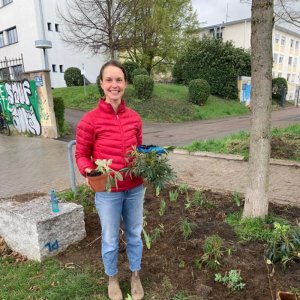
#NetworkNatureReads is inspired by #ReadingRainbow and the #NewYorkTimes #ByTheBook series, both of which spread a love of reading by highlighting standout books and the people who love them. Our goal is to do the same, but with a #naturebasedsolutions flavor. Every month, we will feature one book selected by a NetworkNature member. We believe that literature widens perspectives and can foster connection between human and environmental communities. Read I Am Filled with Love by Anna Swirszczynska if you aren't sure what we mean!
This month’s interviewee is Kelly Heid, a gardener and researcher committed to furthering nature conservation by building empathy.
Want to feature a book on NetworkNature Reads? Contact hello@networknature.eu to find out how!
Tell us about yourself! What role do nature and reading play in your life?
A native Michigander, I grew up playing in the woods behind our house in a suburb of Detroit. My mother was a teacher and librarian and she kept a kitchen garden during my early childhood. I learned to love gardening and reading from her, and now as a mother myself, it’s important to me to pass the joy of reading and nature onto my own children. I always have several books going - usually one fiction book (most recently Birnam Wood by Elinor Catton), one non-fiction (currently Solitary by Albert Woodfox) and something related to nature or gardening (at the moment it’s Seeing Trees: A History of Street Trees in New York City and Berlin by Sonja Dümpelmann). I’m working on a PhD about urban nature-based solutions so there are always a few academic journal articles in the mix as well.
Which book did you pick and why?
I’m sharing The Well-Gardened Mind: The Restorative Power of Nature by Sue Stuart-Smith because I admire the author and the way she seamlessly pulls together personal history, social science, and psychology in this book. Stuart-Smith is a psychiatrist and gardener, and she writes from the heart in this book while also bringing in evidence and practical experience. My book is heavy with underlined passages, sticky notes, and pages of references in my journal. It’s a book I know I will come back to again and again as a scientist and as a gardener.
Can you share a specific moment from the book that resonates with you personally? How does it connect to your work with Nature-based Solutions projects?
Stuart-Smith opens a chapter with a quote from Thomas Fuller (1654-1734), ‘Many things grow in the garden that were never sown there.’ She goes on to write about how through various therapeutic gardening programs people are able to ‘locate themselves’ (p.61) through the process of connecting with nature. She writes about gardening as a powerful therapeutic tool for change, ‘giving participants a different context in which to understand their lives.’ Furthermore, Stuart-Smith mentions a Korean study that used fMRI brain scans to identify that looking at ‘pleasing natural scenery’ activates the parts of the brain involved in generating empathy. (p.107)
I like to think that my work with Nature-based Solutions projects helps to cultivate not only a healthier planet but also healthier and kinder people.
In what ways do you see the themes or lessons from the book aligning with the goals of conservation and the challenges we face in combating biodiversity loss today?
We have to broaden the scope of these topics in every way possible in order to effectively–and joyfully–combat biodiversity loss. Biodiversity needs to matter to everyone, and it needs to be personal. I love when books about conservation and nature connection become mass-market hits because it means the topic is reaching new audiences and influencing people who don’t typically go looking for this kind of information.
If you were recommending this book to a colleague or a friend within the conservation community, what key takeaway or message would you highlight?
Research tells us that people who feel more connected to nature do more to protect it. The journey to more nature connection can start with a simple act of growing flowers in a window box or planting a pumpkin seed in your backyard. The power of gardening –and more broadly spending time in nature– is a simple and evidence-based activity that promotes biodiversity and health.
